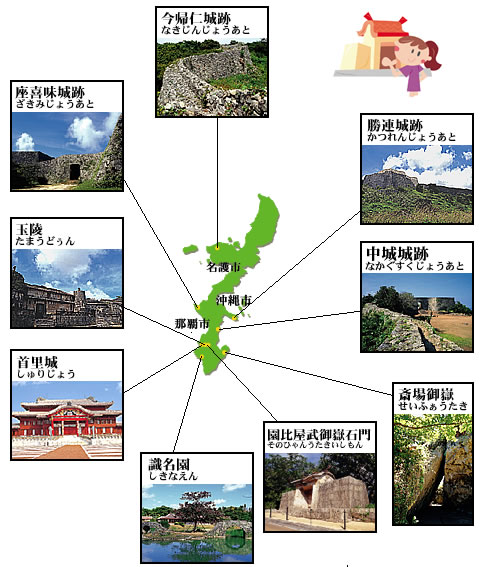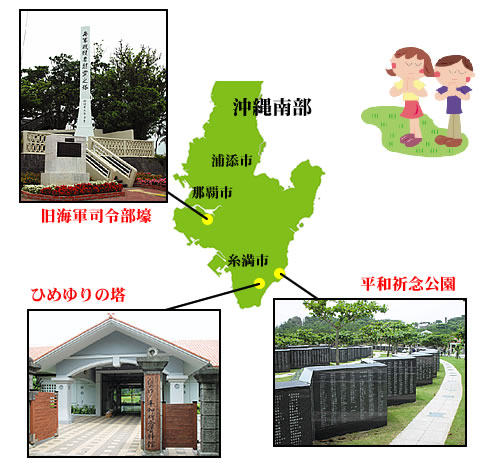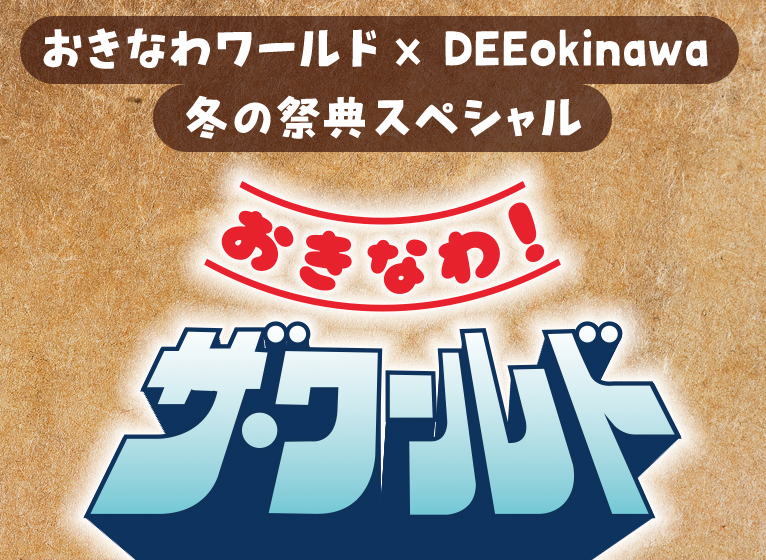
Prefectural flower "Daigo"

Deigo is native to India and is a deciduous Takagi of the legume family.
3. May, crimson flaming flowers bloom. Wood is used as a material for lacquerware.
Prefectural tree "Ryukyuumatsu"

It is a tree unique to Okinawa and reaches around 15m in height. The branches are very beautiful and stunning, resistant to sea breeze damage, and are often planted as protected forests and street trees.
Prefectural bird "Noguchigera"

It is a species of woodpecker that is rare in the world and inhabits only the northern part of Okinawa Island. It is designated as a national natural monument.
Prefectural fish "Takasago"

A beautiful fish of around 25 cm in colorful fediaceae. It is caught throughout the year, and is known by the citizens of the prefecture by the name of the dialect Gurukun.
Introducing Ryukyu culture, registered in World Heritage in 2000 and is attracting worldwide attention!

Nakijinjo Ruins
Yamashiro, built around the 13th and 14th centuries, is located at an altitude of about 100 meters, and it was an impregnable castle. It was the residence of Kitayamano during the Miyama era, but was invaded by Hashi Sho in 1416, and later became the residence of Kitayama supervisor of Shuriofu.
Address: Ima Nakijin Village Imadomari 4874
Phone: 0980-56-4400 (Imakijin Castle Ruins Management Office)
Sales / 8:30 to 18:00 (November and March until 17:30)
Holidays/No holidays
Fee: 400 yen for adults, 300 yen for elementary, junior high and high school students, free for elementary school students
Access / Bus: 2-minute walk from the entrance of the bus stop at the station.
Phone: 0980-56-4400 (Imakijin Castle Ruins Management Office)
Sales / 8:30 to 18:00 (November and March until 17:30)
Holidays/No holidays
Fee: 400 yen for adults, 300 yen for elementary, junior high and high school students, free for elementary school students
Access / Bus: 2-minute walk from the entrance of the bus stop at the station.
The ruins of Katsurenjo Castle
Katsuren Castle was built around the 11th and 12th centuries. castle owner was the residence of Ama Kazutoshi, the most powerful Anji to Kingdom of ryukyu. Kazutoshi Ama tried to regain the kingship and attacked Shuri Castle, but he was defeated and destroyed.
Address: Heian name 3032, Katsuren-cho, Uruma City
Phone: 098-978-2227 (Katsurencho Board of Education)
Free to visit
Holidays/No holidays
Fee / Free admission
Access / Bus: A 5-minute walk from Nishihara bus stop
Phone: 098-978-2227 (Katsurencho Board of Education)
Free to visit
Holidays/No holidays
Fee / Free admission
Access / Bus: A 5-minute walk from Nishihara bus stop
Nakagusukujo Ato (the site of Nakagusukujo Castle)
Nakagusuku Castle is a castle where Gosamaru, who was ordered by Shuri Royal Government, moved to check Katsuren Castle owner, Kazutoshi Ama. The walls are made by taking advantage of the terrain, and the castle construction technology has been highly evaluated historically.
Address: 503 Oshiro, Kitanakagusuku Village
Telephone / 098-935-5791 (Nakagushiro Castle Ruins Joint Management Council)
Open / 8:30 to 18:00 (summer season) Until 17:00 in winter
Holidays/No holidays
Fee: 300 yen for adults, 200 yen for junior and senior high school students, 100 yen for elementary and junior high school students
Telephone / 098-935-5791 (Nakagushiro Castle Ruins Joint Management Council)
Open / 8:30 to 18:00 (summer season) Until 17:00 in winter
Holidays/No holidays
Fee: 300 yen for adults, 200 yen for junior and senior high school students, 100 yen for elementary and junior high school students
Seifu-Utaki
Seiba Utaki is the highest sanctuary in Kingdom of ryukyu and is said to be one of the seven Mitakes, including the country, created by the god Ama Mikiyo. Even now, it is still the subject of people's faith, and those who come to your request will not be forgotten. There is a solemn atmosphere around here.
Address: Nanjo City Chinenji Kuteken 2 Sayakahara
Phone: 098-948-1149 (Chinenson Board of Education)
Free to visit
Holidays/No holidays
Fee / Free admission
Access / Bus: Shikiya Line bus stop, 5 minutes walk from the Sports Center entrance bus stop
Phone: 098-948-1149 (Chinenson Board of Education)
Free to visit
Holidays/No holidays
Fee / Free admission
Access / Bus: Shikiya Line bus stop, 5 minutes walk from the Sports Center entrance bus stop
The Stone Gate of Sonohyan Utaki (The Hyan Utaki)
Onbiya Take Utaki is located between Shureimon and Shuri Castle Kaimon, and is a place where the king prayed for safety along the way when going out. Ryukyu limestone is used for the stone gate, and it is said that it was built in 1519 by Nisito, a master craftsman of Taketomijima.
Address / Makazushi Shuri, Naha City 1-7
Telephone / 098-853-5776 (Naha City Board of Education Cultural Properties Division)
Free to visit
Access/Same as Shuri Castle
Telephone / 098-853-5776 (Naha City Board of Education Cultural Properties Division)
Free to visit
Access/Same as Shuri Castle
Shikinaen
In stroll garden, which aims to enjoy the changing scenery while walking around the pond, was built in 1799 to welcome foreign ambassadors and to recuperate the royal family. On the island floating in a large pond, you must see the Rokkakudo of the Chinese arbor and the arch bridge made of Ryukyu limestone.
Address: Maaji, Naha-shi Godonohara
Telephone: 098-855-5936 (Ishinaen Management Office)
Sales / 9:00 - 17:30 (October? March? 17:00)
Holidays / Wednesday
Fee: Adults 300 yen (high school students and above), Children 100 yen (elementary and junior high school students)
Access / Bus: The Shuri Ishikina Line hachiban / Shishikina Line bus stop at Shishikinaenmae bus stop immediately
Telephone: 098-855-5936 (Ishinaen Management Office)
Sales / 9:00 - 17:30 (October? March? 17:00)
Holidays / Wednesday
Fee: Adults 300 yen (high school students and above), Children 100 yen (elementary and junior high school students)
Access / Bus: The Shuri Ishikina Line hachiban / Shishikina Line bus stop at Shishikinaenmae bus stop immediately
Shuri Castle
Shuri Castle was the residence of successive kings from 1429 to 1879 when Miyama was unified by Hashi Sho (Shohashi). It was burned down four times, including the previous Battle of Okinawa, but was rebuilt in 1992, the 20th anniversary of Okinawa's return to the mainland.
Address: 1-2, Shuri Kinjocho, Naha City
Phone: 098-886-2020
Open/9:00 - 18:00 Seasons (Please contact Shuri Castle for details.)
Holidays/No holidays (However, due to maintenance, there are temporary closures two or three times a year)
Fee: 800 yen for adults, 600 yen for high school students, 300 yen for elementary and junior high school students. Free wheelchair rental available
Access / Monorail: Get off at Gibo Station and Shuri Station, a 15-minute walk bus: Shuri-ban Line / Ishimine Line / Ishimine Line / Itoman-shi bus stop / 3 minutes walk from Shuri Castle
Phone: 098-886-2020
Open/9:00 - 18:00 Seasons (Please contact Shuri Castle for details.)
Holidays/No holidays (However, due to maintenance, there are temporary closures two or three times a year)
Fee: 800 yen for adults, 600 yen for high school students, 300 yen for elementary and junior high school students. Free wheelchair rental available
Access / Monorail: Get off at Gibo Station and Shuri Station, a 15-minute walk bus: Shuri-ban Line / Ishimine Line / Ishimine Line / Itoman-shi bus stop / 3 minutes walk from Shuri Castle
Tamaudun (Tamaudun)
He was a tomb mausoleum of successive Imperial lineages of the second Sho clan. A tomb built by King Shoshin in 1501 to store the remains of his father, King Shoen. Tamaudun resembles the main building of Shuri Castle, and a stone column engraved with beasts and flowers is attached in front of the grave room.
Address: 1-3, Shuri Kinjocho, Naha City
Phone: 098-885-2861
Sales / 8:30 to 18:00
Holidays/No holidays
Fee / Adult 200 yen (16 years old or older), Children 100 yen (7 years old or 15 years old) ※Free wheelchair rental available
Access/Same as Shuri Castle
Phone: 098-885-2861
Sales / 8:30 to 18:00
Holidays/No holidays
Fee / Adult 200 yen (16 years old or older), Children 100 yen (7 years old or 15 years old) ※Free wheelchair rental available
Access/Same as Shuri Castle
Zakimi-jo Castle Ruins
Zakimi Castle was built around the beginning of the 15th century by the famous castle architect Gosamaru. The wall piled with a unique curve is a technique called "Aikata stacking". In addition, the arch-shaped stone gate is said to be the oldest in Okinawa.
Address: Yomitan Village Zakimi 708
Phone: 098-958-3141 (Yomitan Village History and Folklore Museum)
Free to visit
Holidays/No holidays
Access / Bus: Yomitan bus stop / 15 minutes walk from Yomitan bus stop / 10 minutes walk from Yomitan bus stop at Yomitan bus stop
Phone: 098-958-3141 (Yomitan Village History and Folklore Museum)
Free to visit
Holidays/No holidays
Access / Bus: Yomitan bus stop / 15 minutes walk from Yomitan bus stop / 10 minutes walk from Yomitan bus stop at Yomitan bus stop

Underground Naval Headquarters
Opened the headquarters bunker as it was at that time.
The former Navy Command Bunker is the place where the Japanese Navy Okinawa Base Corps Headquarters during the Okinawa War was located. It was rebuilt in 2004, and a part of the bunker was opened to the public, and a museum is also attached. In the bunker, the commander's office, the operating room, the medical office, etc. remain as it was at that time, conveying the misery of the war. It is an air raid shelter dug by the Japanese Navy Construction Corps (Yamane Unit) in 1944, and is said to have been 450m at that time. Approximately 4,000 soldiers were housed in this room in preparation for an endurance battle, hardened the side hole dug into a Kamaboko-shaped shape with concrete and mines, hardened with U.S. gunfire. In a narrow bunker, the soldiers had to sleep standing. It was left for a while after the war, but after several collections of ashes, about 300 meters were restored around the commander's office in 1970 and opened to the public. In the attached museum, relics and photographs found in the bunker are displayed.
The former Navy Command Bunker is the place where the Japanese Navy Okinawa Base Corps Headquarters during the Okinawa War was located. It was rebuilt in 2004, and a part of the bunker was opened to the public, and a museum is also attached. In the bunker, the commander's office, the operating room, the medical office, etc. remain as it was at that time, conveying the misery of the war. It is an air raid shelter dug by the Japanese Navy Construction Corps (Yamane Unit) in 1944, and is said to have been 450m at that time. Approximately 4,000 soldiers were housed in this room in preparation for an endurance battle, hardened the side hole dug into a Kamaboko-shaped shape with concrete and mines, hardened with U.S. gunfire. In a narrow bunker, the soldiers had to sleep standing. It was left for a while after the war, but after several collections of ashes, about 300 meters were restored around the commander's office in 1970 and opened to the public. In the attached museum, relics and photographs found in the bunker are displayed.
Address: 614-1, Mabuni, Itoman-shi
Phone: 098-997-3844
Opening hours: 9:00?17:00
Closed days: Monday
(Open if Monday is a holiday), New Year's holidays (December 29 to January 3), temporary closed days
Entrance fee: 300 yen for adults and 150 yen for children
Phone: 098-997-3844
Opening hours: 9:00?17:00
Closed days: Monday
(Open if Monday is a holiday), New Year's holidays (December 29 to January 3), temporary closed days
Entrance fee: 300 yen for adults and 150 yen for children
Okinawa Peace Memorial Museum
Experience and learn the importance of War and Peace in a comprehensive manner.
A tower and a peace memorial museum dedicated to the Himeyuri students who died in the Battle of Okinawa and achieved a tragic end. In the museum, relics and materials of the student corps are displayed. In March 1945, students from the former Okinawa Daiichi Girls' School and the former Okinawa Normal School Women's Club were assigned to the Army Hospital as special nurses. In the dark and narrow bunkers, they were desperately nursing the wounded soldiers. The hospital had to move along with the front, and in late May I came to the buni shelter in Mabuni Ihara, but soon it was also surrounded by the U.S. military, and this became their last place. 187 students and 14 teachers were killed in battle here. The spirit of the maidens who lost their lives at a young age is enshrined.
A tower and a peace memorial museum dedicated to the Himeyuri students who died in the Battle of Okinawa and achieved a tragic end. In the museum, relics and materials of the student corps are displayed. In March 1945, students from the former Okinawa Daiichi Girls' School and the former Okinawa Normal School Women's Club were assigned to the Army Hospital as special nurses. In the dark and narrow bunkers, they were desperately nursing the wounded soldiers. The hospital had to move along with the front, and in late May I came to the buni shelter in Mabuni Ihara, but soon it was also surrounded by the U.S. military, and this became their last place. 187 students and 14 teachers were killed in battle here. The spirit of the maidens who lost their lives at a young age is enshrined.
Address: 671-1, Ihara, Itoman-shi
Phone: 098-997-2100
Opening hours: 9:00?17:00
Closed days: Open all year round
Entrance fee: 300 yen for adults, 200 yen for high school students, 100 yen for elementary and junior high school students
Phone: 098-997-2100
Opening hours: 9:00?17:00
Closed days: Open all year round
Entrance fee: 300 yen for adults, 200 yen for high school students, 100 yen for elementary and junior high school students
Himeyuri Tower and Himeyuri Peace Memorial Museum
Learn about war from the history of the Himeyuri students.
The former Navy Command Bunker is the place where the Japanese Navy Okinawa Base Corps Headquarters during the Okinawa War was located. It was rebuilt in 2004, and a part of the bunker was opened to the public, and a museum is also attached. In the bunker, the commander's office, the operating room, the medical office, etc. remain as it was at that time, conveying the misery of the war. It is an air raid shelter dug by the Japanese Navy Construction Corps (Yamane Unit) in 1944, and is said to have been 450m at that time. Approximately 4,000 soldiers were housed in this room in preparation for an endurance battle, hardened the side hole dug into a Kamaboko-shaped shape with concrete and mines, hardened with U.S. gunfire. In a narrow bunker, the soldiers had to sleep standing. It was left for a while after the war, but after several collections of ashes, about 300 meters were restored around the commander's office in 1970 and opened to the public. In the attached museum, relics and photographs found in the bunker are displayed.
The former Navy Command Bunker is the place where the Japanese Navy Okinawa Base Corps Headquarters during the Okinawa War was located. It was rebuilt in 2004, and a part of the bunker was opened to the public, and a museum is also attached. In the bunker, the commander's office, the operating room, the medical office, etc. remain as it was at that time, conveying the misery of the war. It is an air raid shelter dug by the Japanese Navy Construction Corps (Yamane Unit) in 1944, and is said to have been 450m at that time. Approximately 4,000 soldiers were housed in this room in preparation for an endurance battle, hardened the side hole dug into a Kamaboko-shaped shape with concrete and mines, hardened with U.S. gunfire. In a narrow bunker, the soldiers had to sleep standing. It was left for a while after the war, but after several collections of ashes, about 300 meters were restored around the commander's office in 1970 and opened to the public. In the attached museum, relics and photographs found in the bunker are displayed.
Address: 236, Tomigusuku, Tomigusuku-shi
Phone: 098-850-4055
Opening hours: 8:30?17:00
Closed days: Open all year round
Entrance fee: 420 yen for adults and 210 yen for children
Phone: 098-850-4055
Opening hours: 8:30?17:00
Closed days: Open all year round
Entrance fee: 420 yen for adults and 210 yen for children

